Time Doctor remains one of the most talked-about employee-monitoring systems, yet in 2025 the market offers far more flexible solutions. Some companies want a tool that records actual hours without invading employees’ privacy; others need a lower price point or deeper project analytics. Below we examine ten relevant Time Doctor alternatives, highlight their strengths, and suggest which platform best fits your team.
Why Do Users Look for Alternatives to Time Doctor?
Traditional “hard” monitoring — random screenshots, URL logs, and keystroke recording — sparks growing concern among knowledge workers. These methods can erode trust and, in several regions, already fall under GDPR-style restrictions. Beyond ethics, Time Doctor raises several practical issues:
- Implementation hurdles: the more “spying” features you enable, the harder it is to convince the team to install the client and start timers consistently.
- High price tag: a mid-sized business pays at least $10 per user per month for Premium, and advanced analytics cost even more.
- Limited report customization: managers often merge exports manually before showing clients a clear picture.
- Legal risks: in the EU, Canada, and some U.S. states, employers must formally disclose monitoring methods — something Time Doctor users occasionally overlook.
- Rigid interface: enterprises complain they can’t selectively disable certain controls (e.g., URL logging) for specific departments.
Criteria for Choosing a Modern Time Tracker
When businesses ask which time tracker to adopt instead of Time Doctor, seven universal criteria surface.
- Transparency for employees. A service should clearly show what it records — timer, active windows, links, or only tasks.
- Flexible control levels. One department may need minimal tracking, another deep metrics.
- Easy timer launch. The fewer clicks to start, the higher the compliance. Auto-trackers such as Timely and RescueTime go further and remove “I forgot” headaches entirely.
- Visual reporting. Final tables and charts must be clear not only to HR but also to clients paying for the hours.
- Integrations with task managers. Compatibility with Asana, Jira, Trello, or Slack saves context-switching time.
- Transparent pricing without hidden upsells. “All features on every plan” is Worksection’s strong argument against competitors.
- Team analytics and AI insights. In 2025 many tools predict burnout or highlight bottlenecks based on project data.
Best Time Doctor Alternatives in 2025
Worksection
Worksection stands out by merging task management and time tracking inside one streamlined platform. The timer lives directly in each task card: click “Start,” work, press “Stop,” and hours instantly appear in the report. An optional automatic mode records activity by open tabs, yet the service intentionally avoids harsh surveillance — no random screenshots or keylogging, only honest hour capture per task. The interface supports three views — list, Kanban board, and Gantt chart — while the calendar shows team workload a week ahead. Every feature, including the tracker, is available even on the entry plan (from $3.99 per user per month). Thanks to its affordable price and lack of hidden upgrades, Worksection is a strong Time Doctor alternative for agencies, product teams, and freelance studios that value trust and transparency.
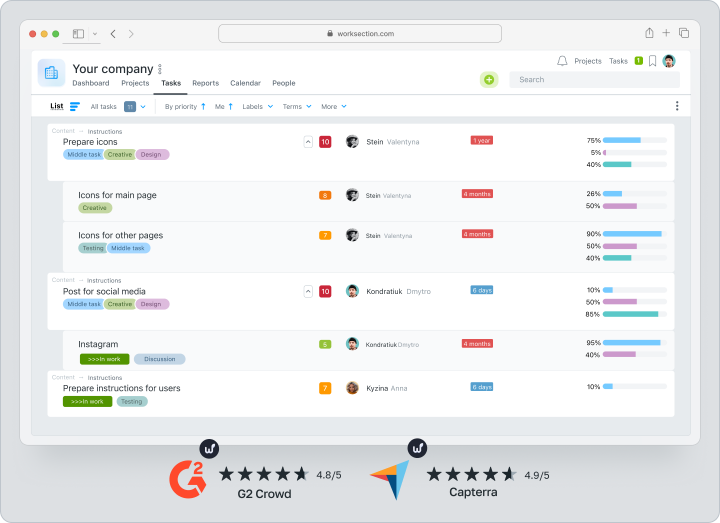
Hubstaff
Hubstaff targets companies with fully remote or field employees. The app records GPS coordinates, takes screenshots, and measures mouse and keyboard activity. Managers receive route maps and detailed timesheets — ideal for service crews or staff-augmentation models, less comfortable for creative teams. The base plan starts at $7 per user per month; advanced features (auto-scheduling, payroll) unlock with Premium.
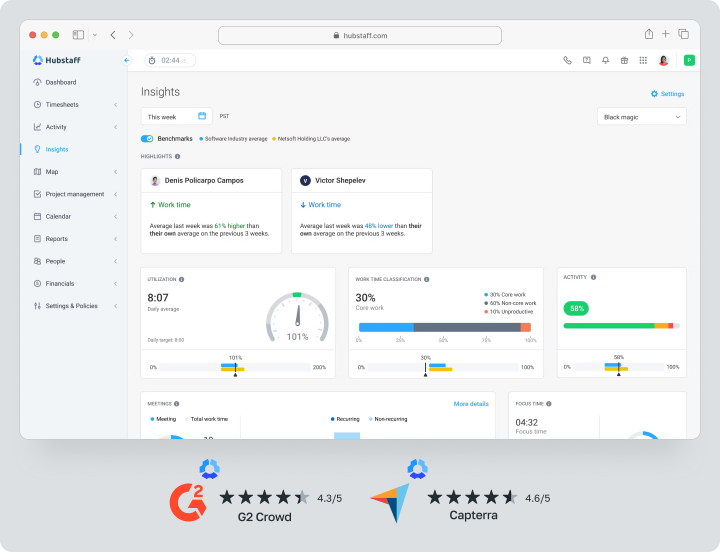
ActivTrak
ActivTrak positions itself as a cloud people-analytics platform. It not only counts hours but classifies apps as “productive” or “distracting,” builds focus-time reports, and spots hidden losses. Machine-learning algorithms chart trends by department, letting HR detect burnout early. Pricing begins at $10 per user; enterprise clients can connect an API and train custom productivity models.
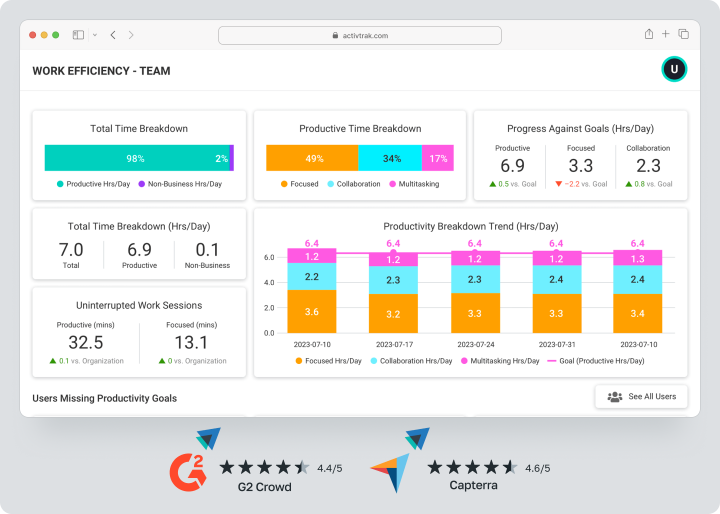
Clockify
Clockify remains the most popular free time tracker: unlimited projects, reports, and integrations really cost nothing. Paid options (from $3.99 per user per month) add budget controls, invoice templates, and role-based time approvals. For teams seeking a cheap yet honest Time Doctor replacement, Clockify is a solid starting point.
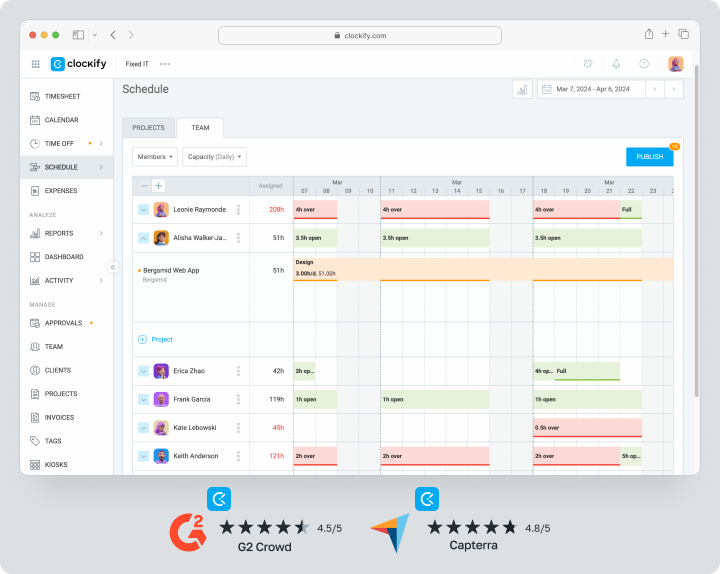
RescueTime
RescueTime is designed as a personal productivity assistant: the app runs quietly in the background, tracks where time goes, and provides a daily digest. There’s little team control — great for individuals who want discipline without oversight. In 2025 the service costs $6.67 per user per month (annual billing) and offers smart alerts that block “dangerous” sites when procrastination exceeds limits.
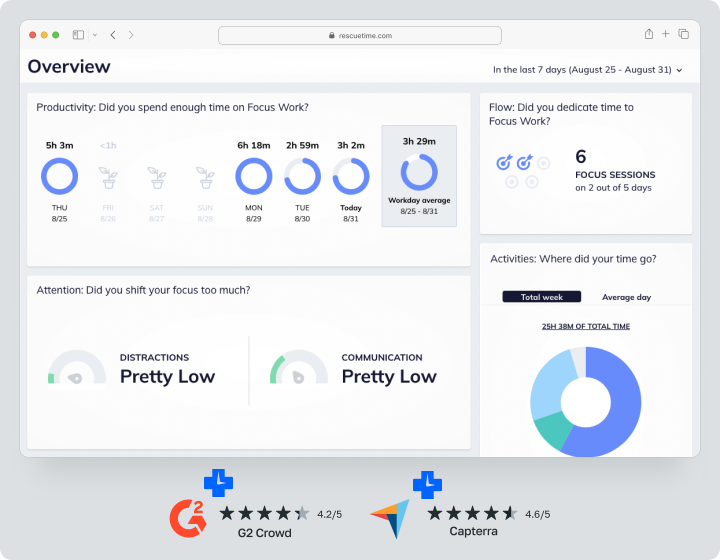
Timely
Norwegian platform Timely bets on AI auto-tracking: the program records which files, tabs, and calendar events are open, then asks users to confirm time blocks. This removes “forgot to start the timer” pain while keeping privacy in human hands. Prices start at $11 per user per month, and higher plans allow data anonymization for ethical analytics.
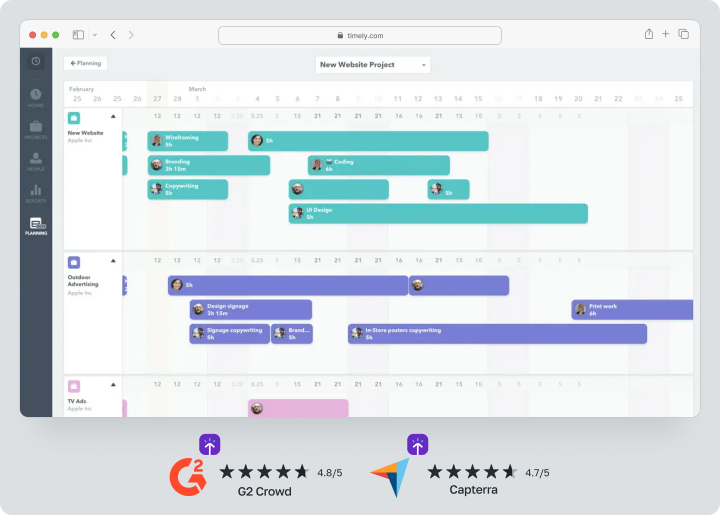
TMetric
TMetric is a lean tracker for freelancers and small product teams. Users launch a timer from the browser or desktop app, then assign hours to projects and rates. The platform handles budgets, client invoices, and CSV exports. The Business plan costs $5 per user per month, while deeper Jira and Redmine integration appears in the Enterprise tier.
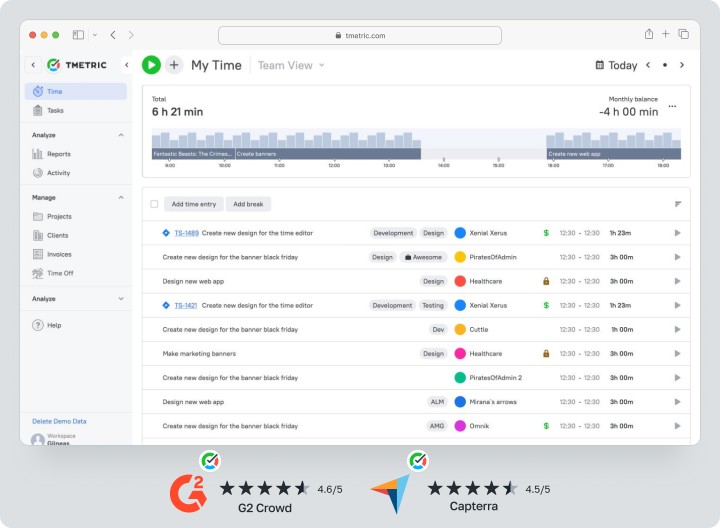
Everhour
Everhour is known for seamless integration with Asana, ClickUp, and Trello. The tracker embeds directly into each task interface and displays live hours in lists, speeding up stand-ups and retros. The system visualizes resources, helps issue invoices, and controls sprint budgets. Base price: $8.50 per user per month (annual).
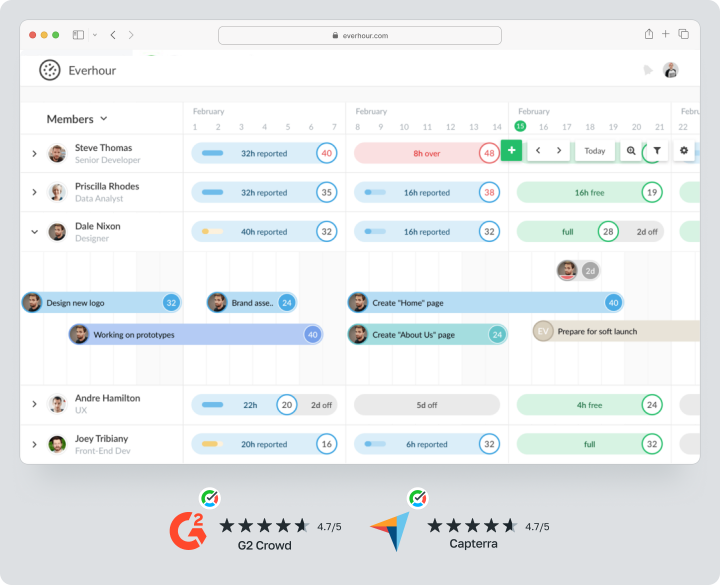
Desktime
Desktime evolved as an office-centric time counter: auto-tracking starts when the PC boots, the service records idle periods, builds productivity charts, and schedules shifts. Perfect for classic 9‑to‑6 offices and call centers where exact clock-in matters. The Pro plan costs $7 per user per month; the “Leave Planner” add-on is sold separately.
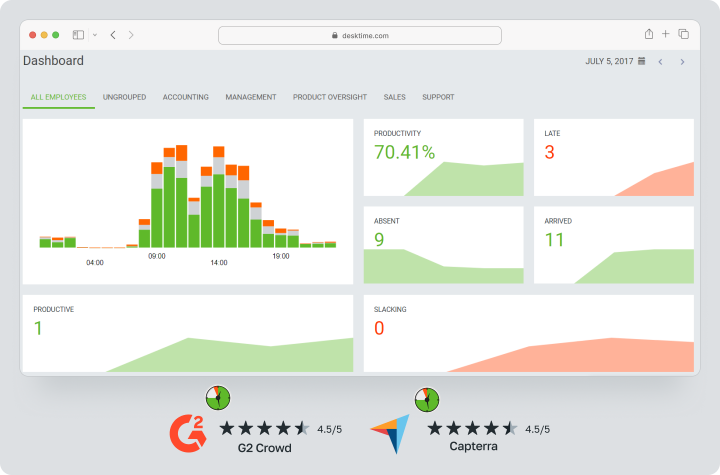
Insightful
Formerly Workpuls, Insightful combines traditional employee monitoring with performance management. The software can capture screenshots, log applications, analyze workload, and display activity heatmaps. Companies with strict SLAs use these reports to pinpoint bottlenecks quickly. Pricing starts at $8 per user per month; enterprise clients may request an on-premise build.
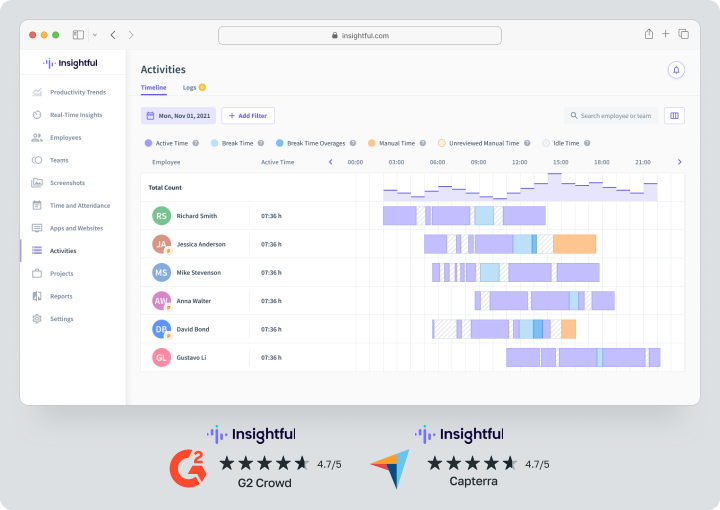
Comparison Table of Top Time Doctor Alternatives
| Service | Control Style | Time Tracker | Key Strength | Price From |
| Worksection | No screenshots, trust-based | Manual/auto | Task manager + tracker in one | $3.99/user |
| Hubstaff | Screenshots, GPS, activity | Manual | Field-team monitoring | $7/user |
| ActivTrak | Screenshots, website categories | Auto | AI-driven people analytics | $10/user |
| Clockify | No screenshots | Manual | Fully featured free tier | Free |
| RescueTime | No team control | Auto | Personal productivity coach | $6.67/user |
| Timely | No screenshots | Auto (AI) | Full automation of tracking | $11/user |
| TMetric | URL log, idle detection | Manual | Budgets & invoices for freelancers | $5/user |
| Everhour | No screenshots | Manual | Deep task-manager integration | $8.5/user |
| Desktime | Screenshots, idle time | Auto | Shift planner for offices | $7/user |
| Insightful | Screenshots, optional keylogging | Manual/auto | Heatmaps & on-prem option | $8/user |
Which Platform Should You Choose in 2025?
If your company needs strict employee monitoring with detailed screenshots and GPS, consider Hubstaff or Insightful. They deliver maximum transparency but demand careful legal groundwork and strong trust with staff. Teams wanting a softer replacement for Time Doctor should try Worksection, Timely, or Clockify: these tools remove privacy headaches yet deliver precise hour reports. Worksection wins by combining task management, time tracking, and an affordable price tag — a mix rarely found elsewhere.Frequently Asked Questions (FAQ)
Which Time Doctor alternative works best for agencies?
Creative agencies need to switch projects quickly and produce client-friendly reports. Worksection (task manager + tracker in one), Everhour (seamless Asana link), and TMetric (flexible rates and invoices) top the list.
Are there any free Time Doctor equivalents?
Clockify offers a genuinely free plan with no project limits. RescueTime has a trimmed free version for personal use, and Worksection provides free access for teams of up to five users within a project cap.
How is Worksection different from Time Doctor?
Time Doctor centers on employee surveillance — screenshots, URL logs, keylogs. Worksection focuses on outcomes: you manage tasks, start the timer in each card, and get reports without intrusive spying. Because all features (Kanban, Gantt, calendar, tracker) come even in the base plan, companies save money and avoid stressing their teams.